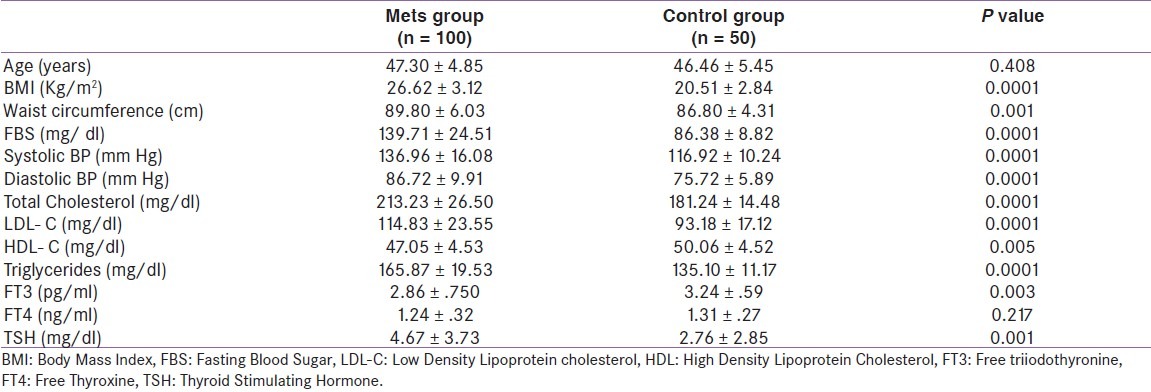Abstract
Aim:
Metabolic syndrome (MetS) and hypothyroidism are well established forerunners of atherogenic cardiovascular disease. Considerable overlap occurs in the pathogenic mechanisms of atherosclerotic cardiovascular disease by metabolic syndrome and hypothyroidism. Insulin resistance has been studied as the basic pathogenic mechanism in metabolic syndrome.[1] This cross sectional study intended to assess thyroid function in patients with metabolic syndrome and to investigate the association between hypothyroidism and metabolic syndrome.
Materials and Methods:
One hundred patients with metabolic syndrome who fulfilled the National Cholesterol Education Program- Adult Treatment Panel (NCEP-ATP) III criteria [ 3 out of 5 criteria positive namely blood pressure ≥ 130/85 mm hg or on antihypertensive medications, fasting plasma glucose > 100 mg/dl or on anti-diabetic medications, fasting triglycerides > 150 mg/dl, high density lipoprotein cholesterol (HDL-C) < 40 mg/dl in males and < 50 mg/dl in females, waist circumference > 102 cms in men and 88 cms in women] were included in the study group.[2] Fifty patients who had no features of metabolic syndrome (0 out of 5 criteria for metabolic syndrome) were included in the control group. Patients with liver disorders, renal disorders, congestive cardiac failure, pregnant women, patients on oral contraceptive pills, statins and other medications that alter thyroid functions and lipid levels and those who are under treatment for any thyroid related disorder were excluded from the study. Acutely ill patients were excluded taking into account sick euthyroid syndrome. Patients were subjected to anthropometry, evaluation of vital parameters, lipid and thyroid profile along with other routine laboratory parameters. Students t-test, Chi square test and linear regression, multiple logistic regression models were used for statistical analysis. P value < 0.05 was considered significant.
Results:
Of the 100 patients in study group, 55 were females (55%) and 45 were males (45%). Of the 50 persons in control group, 26 (52%) were females and 24 (48%) were males. The baseline characteristics of two groups are depicted in. The two groups were similar with respect to age and sex distribution. However, body mass index, waist circumference, mean systolic pressure, diastolic pressure, fasting blood sugar, total cholesterol, LDL-C, triglycerides and TSH were significantly higher in study group compared to control group. HDL-C was significantly lower in study group.
Keywords: Hypothyroidism, metabolic syndrome
In linear regression model, showing correlation between the components of metabolic syndrome with levels of TSH [Table 1 and 2]. TSH had significant positive linear association with Triglycerides, total cholesterol, LDL-C and significant negative linear association with HDL-C. Distribution of thyroid dysfunction across the group was analyzed in the study. In the MetS group, 4 (4%) of the cases had overt hypothyroidism, 22 (22%) had subclinical hypothyroidism and 74 (74%) were euthyroid. In the control group, 1 (2%) had overt hypothyroidism, 4 (8%) had subclinical hypothyroidism and the rest 45 (90%) were euthyroid. Subclinical hypothyroidism had significant association with metabolic syndrome when assessed by Chi square test with P = .03.
Table 1.
Baseline characteristics of the study population. All data expressed as mean ± standard deviation. P < 0.05 is statistically significant

Table 2.
Correlation between components of metabolic syndrome with levels of TSH across the metabolic syndrome group (linear regression model)

Association between subclinical hypothyroidism and components of metabolic syndrome was analyzed using logistic regression analysis [Table 3].
Table 3.
Association between patient characteristics and subclinical hypothyroidism in the metabolic syndrome group (logistic regression analysis)

Subclinical hypothyroidism showed significant association with BMI when analyzed using logistic regression models in the metabolic syndrome case group (P =.006, CI 0.412 to 0.859).
CONCLUSION
There is significant association between subclinical hypothyroidism and metabolic syndrome. It highlights the importance of thyroid function tests in patients with metabolic syndrome.
Footnotes
Source(s) of Support: None
Presentation at a meeting: None
REFERENCES
- 1.Reaven GM. Banting lecture- Role of insulin resistance in humandisease. Diabetes. 1988;37:1595–607. doi: 10.2337/diab.37.12.1595. [DOI] [PubMed] [Google Scholar]
- 2.Expert Panel on Detection, Evaluation, and Treatment of High Blood Cholesterol in Adults. Executive Summary of The Third Report of The National Cholesterol EducationProgram (NCEP) Expert Panel on Detection, Evaluation, And Treatment of High BloodCholesterol In Adults (Adult Treatment Panel III) JAMA. 2001;285:2486–97. doi: 10.1001/jama.285.19.2486. [DOI] [PubMed] [Google Scholar]


